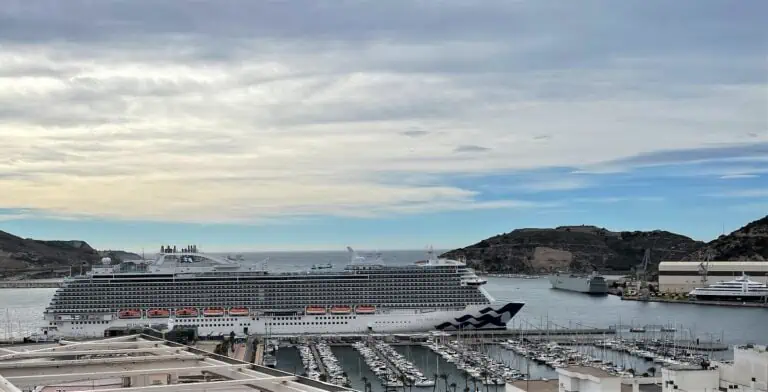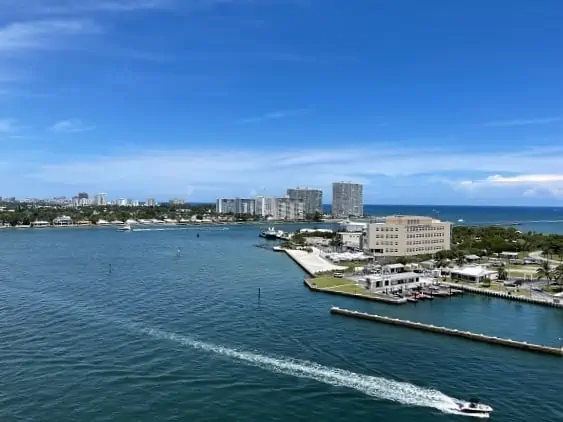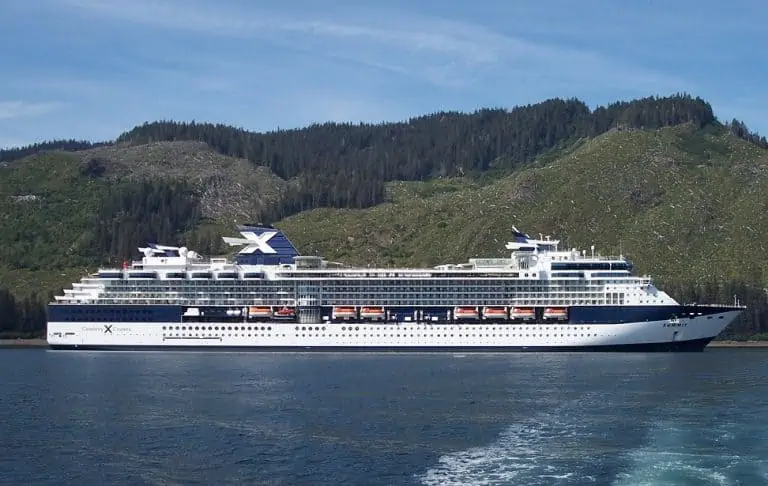How Long is Too Long For A Cruise?
Examining The Pros and Cons of Longer Sailings
Social media has been abuzz about Royal Caribbean’s Ultimate World Cruise this year. On December 10, the Serenade of the Seas started its nine-month journey from Miami. Many “influencers” jumped on the ship, and the cruise became a sensation on TikTok (#ultimateworldcruise) and other sites.
Here we are in April, and that cruise still has FIVE months to sail before it returns to Miami! If you are a TikTok fan, you may still follow along with the cruise, but most of the world has already lost interest. That brings us to this point, “How long is too long for a cruise?”
Honestly, we’ve been considering a “world cruise”; it’s been sitting on our bucket list, waiting for the right time. We just returned from a 32-day South American cruise from Buenos Aires to Los Angeles. Since this was our 27th cruise, you can safely say we like to cruise as a way of travel. However, this cruise also led us to take a world cruise off our bucket list. Here’s how we weighed the pros and cons …
This article may contain affiliate links. We may earn a commission if you use these links to buy products or services. Please see our disclosure policy for full details. Thanks.
So What Are The Pros Of Longer Cruises?
The allure of extended cruises for avid travelers starts with the fact that you can easily go anywhere in comfort and style. Think about it:
- No multiple plane, train, car, or bus trips.
- You only unpack once when you board your vessel.
- Exploration of multiple destinations in one trip.
- Opportunities for immersive cultural experiences.
- Luxurious amenities and onboard entertainment.
- Numerous dining options, from sit-down dinners to poolside pizza.
Most cruise ships that do longer sailings are not the cruise line’s newest, biggest ships. Generally, they are smaller ships holding between 2,000 and 2,500 passengers.
While the size of the ship may not be huge, it still offers nightly entertainment, casino games, different venues for music and dancing, pools, hot tubs, spa services, etc. Everything you would find in a three or four-star hotel.
Notably, most food is already included in your cruise fare. For dinner, you can always eat in the main dining room with a typical 3-course meal, or you can be casual and go to the buffet.





Want something in between? Many ships have casual eateries offering seated service but simpler fare. Or if it is a special occasion, you will usually find specialty restaurants like a steak house or French or Italian on board (note these options typically come with an additional price).
All of the “Pros” above, coupled with stops in exotic-sounding ports like Bora Bora, New Zealand, or Bangkok, make a longer cruise sound like the best option.
But For Every Pro, There is a Con On Longer Cruises
The Challenges of Extended Cruises are many:
- Cabin fever and monotony. This may be the biggest con of a longer cruise.
- Fatigue and burnout: Continuous travel and sightseeing.
- Limited flexibility: Less freedom to deviate from the planned itinerary.
- Missed ports. Yes, due to weather conditions or political instability, your ship’s Captain may decide to skip a port.
Cabin fever, travel fatigue, and burnout are among the cons of longer cruises. Your space will be small unless you pay quite dearly for your cruise ship cabin. The average “balcony” cabin is usually less than 200 sq. ft., including your bathroom.

If you have a balcony, it is your only private outside space. It is small, just the width of your room, and maybe 5 feet deep. Two people living in this space for a month or more can feel claustrophobic.
You may not think you will ever get tired of seeing new ports and cities every few days. But when you’ve been to 10 major destinations in, say, 20 days, and you have to wake up tomorrow and do it again, you wonder if you really want to. It can be exhausting, to say the least.
Of course, there is also limited flexibility; you are going where the ship goes. There may be some options on truly long cruises, such as taking a few days or weeks off and rejoining the ship in a different port. But then, are you cruising or combining cruising and land-based travel?
And what if the one port you genuinely hope to see is canceled due to weather or some other unforeseeable event like a war breaking out in the Middle East?
How Long Is Too Long For A Cruise? Insights On Our 32-Day South American Cruise
The recent 32-day South American Cruise on the Sapphire Princess had 15 ports of call on its original itinerary, which sounded perfect for us. After two transatlantic cruises, we learned that while we like sea days, we don’t want to be at sea for more than three days at a time. The longest sea day stretch in the planned sailing was only two days—cool!
For Us, A Cruise Longer Than 2 Weeks May Be Too Long
The first two weeks of the South American Cruise had some intriguing ports. Buenos Aires, where the voyage started, is a vibrant city and the home of the Tango! Buenos Aires is just a short flight from Iguazu Falls, a World Heritage Site and a must-see phenomenon. So naturally, we took the opportunity to tour this fantastic National Park.
We were fortunate to make port in the Falklands (Malvinas if you are from Argentina). Due to the rough seas here, this port is often missed. However, sailing around Cape Horn (the tip of South America) is not without its issues.
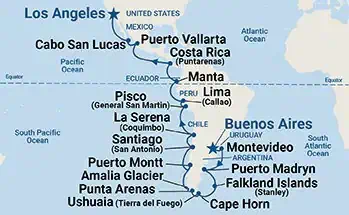
Ushuaia is at the end of the Andes, the continent’s end. It’s as close as you can get to Antarctica before crossing the Southern Ocean.
After Ushuaia, the seas got rougher. Many cruisers were seasick (not something I’m afflicted with). Because of the weather, we missed cruising to Amalia Glacier, which is stunningly over two miles wide at its outlet into the sea. The ship also did not make port in Puerto Montt.
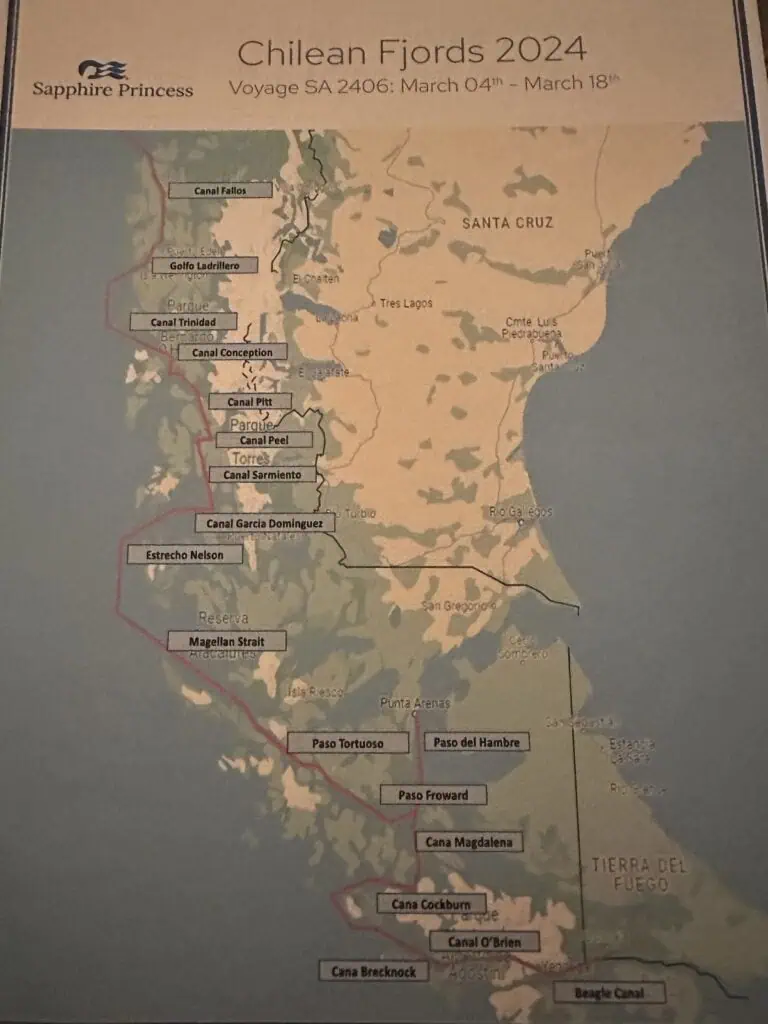
Provided to the Guests By Captain McBain
Instead, Captain Todd McBain, aided by a Chilean Sea Pilot, sailed in and out of the fjords along the Pacific Ocean to keep the ship in calmer waters for four days to our next port in Santiago, Chile. As beautiful as the fjords are, this was the first of two longer-than-planned days at sea.
Santiago Marked the Start Of The 2nd Half Of The Cruise
I enjoyed the port at Santiago as I visited Valparaiso, a city I read about in Isabelle Allende’s “Daughter of Fortune.”
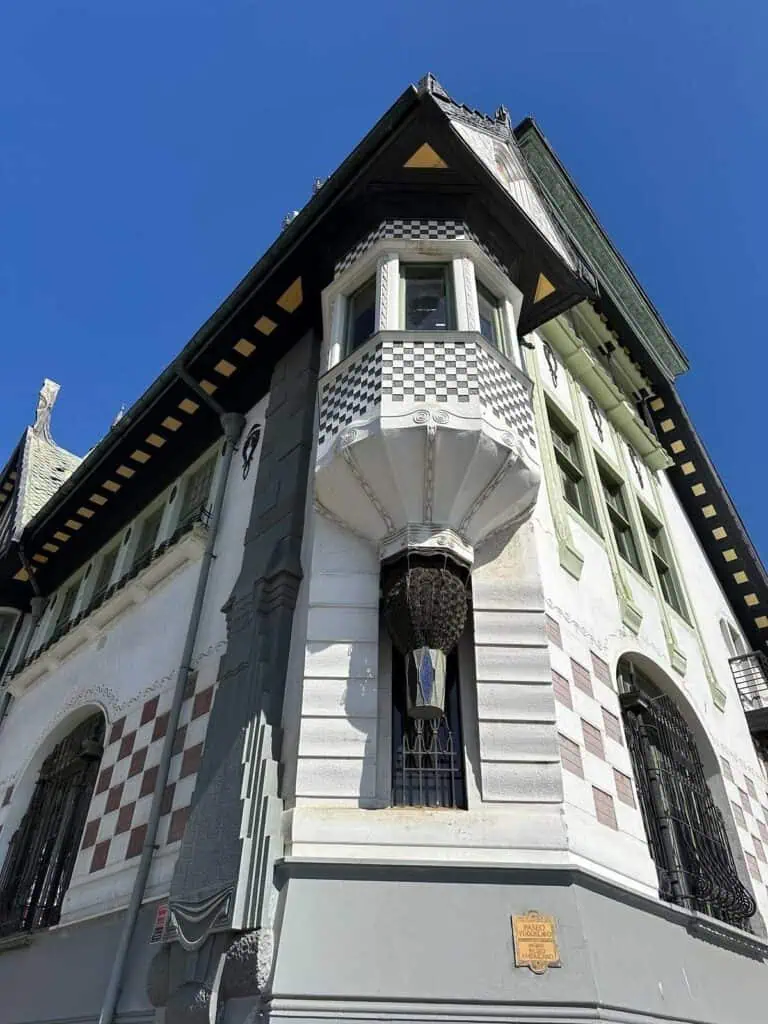
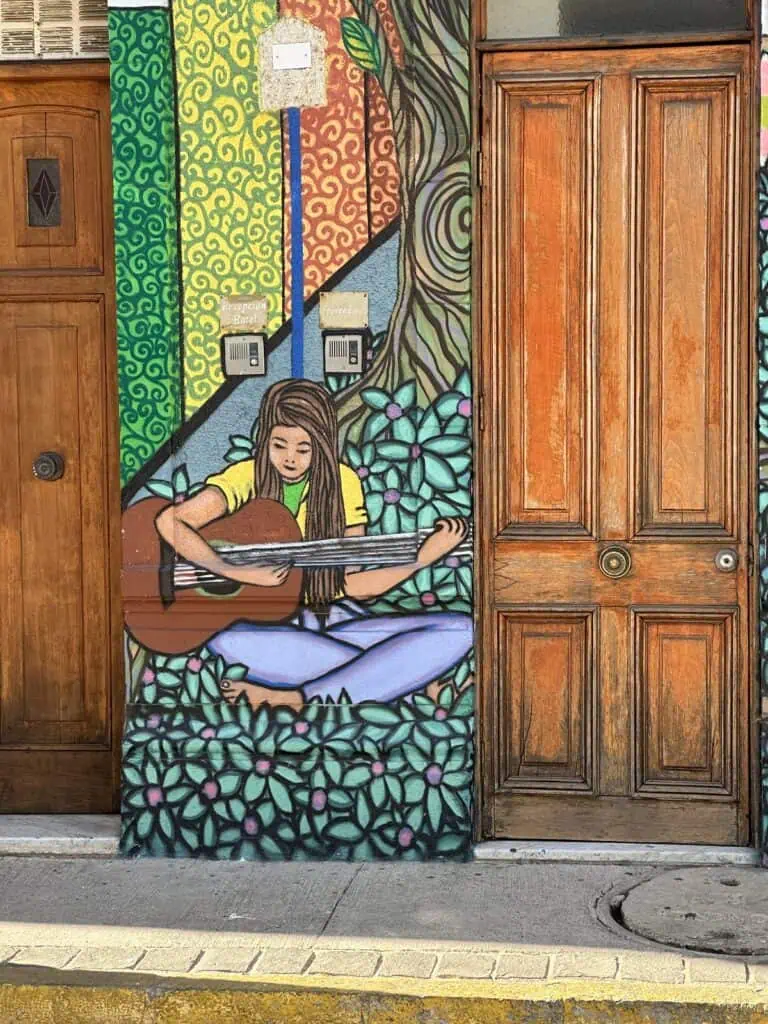
However, many ports on the West Coast of South America are not set up for the tourist trade. If one of the things you like about cruising is beach days in port, you would be disappointed on this cruise.
While not an expedition cruise, many ports were rustic, with hiking and trekking being the shore excursions offered on land. In Pisco, we docked at the naval dockyards. If you wanted to go to the nearest town (which isn’t Pisco), Paracas, it was a 40-minute bus ride.
Because we are more adventurous, we opted for our own tour here. Get Your Guide arranged for a flight over the Nazca Lines out of the Pisco airport. This flight was fantastic, but only a dozen of our fellow cruisers chose to head out there. While this airport is nice, you cannot fly from here to anywhere. The only flights are those over the Nazca Lines and military.
Two groups of cruise passengers made plans through Princess to go to a) Machu Picchu – a 3-day trek and b) the Galapagos, a 4-day adventure. These folks would miss Pisco and Lima, but the trade-off was great.
Unfortunately, the Galapagos group was due back on the ship in Manta, Ecuador. The ship’s Captain decided not to go due to the political unrest in the country at the time. I’m unsure when the group returned to the ship, as our next stop was Puntarenas, Costa Rica.
For those of us on the ship, this meant another long spate of sea days from Lima and 4 more days to stare at the sea and play Bingo (not).
When we finally got to Los Angeles, I was more than ready to leave the ship. However, many of our fellow passengers had just finished the first half of their cruise. They stayed on the ship for the next leg from LA to Hawaii to the South Pacific (Fiji, French Polynesia, etc.) and back, bringing their total cruise days up to 64!
How Long is Too Long For A Cruise? Finding The Right Balance
First-time cruisers could undoubtedly be overwhelmed by a month or more at sea. This is why a Travel Agent (TA for short) often recommends a seven-night cruise in the southern Caribbean for new sailors.
On shorter cruises, you may find that your port calls are limited. For a 7-day cruise or shorter, your travel destinations are limited to how far the ship can sail in that time. This is why many of these cruises stay relatively close to their home base (Miami, Ft. Lauderdale, Los Angeles, etc.)
Longer cruises, around two weeks, are a fun way to sail around Europe or visit the Greek Islands. In two weeks, you can unwind, knowing you won’t be packing your bags just four days after you board the ship. Instead, you have plenty of time to enjoy the ship and more time in the ports of call.
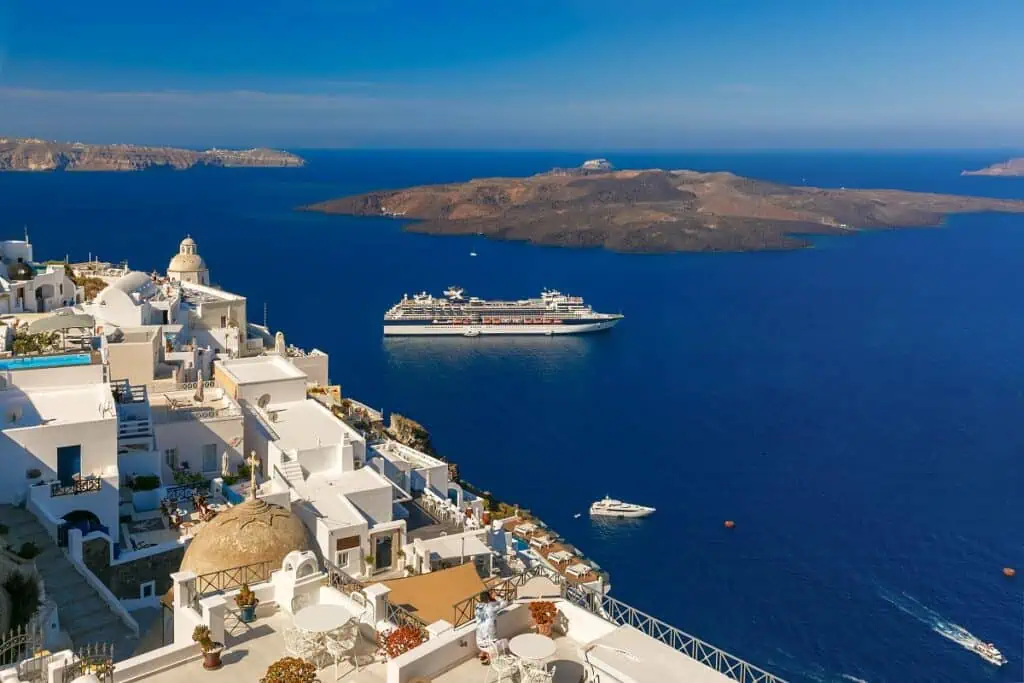
Considering your travel style and tolerance for extended periods at sea is essential. Many cruisers enjoy these intervals of sailing as much, if not more, than the ports they visit.
Between our two Transatlantic crossings and this 32-day semi-circumnavigation of South America, we learned that while we like sea days to rest and regroup, two in a row are fine; after that, we want to be in port.
We like to travel for long periods, so a month or more away from home is fine for us. But a month or more on a cruise ship is not our cup of tea.
What Are Some Alternatives To Extended Cruises?
We paired our first Transatlantic cruise on the Celebrity Reflection with a two-week driving tour of Portugal. This was a fantastic trip; cruising across the Atlantic meant we didn’t arrive in Europe with jet lag. After relaxing for two weeks, we were ready to hop in a car and hit the road.
If you are willing to mix things up (i.e., land and sea travel), you put together some great options and see places you otherwise may not get to.
Don’t want to cruise at all, but do you want to travel around the world? Tour operators can put together around-the-world tour packages that include flights, accommodations, and guided tours to various destinations around the globe. These tours often blend cultural immersion and sightseeing with opportunities to explore multiple countries and regions.
Or you could take a train journey. Traveling by train across continents provides a unique perspective of the landscapes and cultures along the way. Consider iconic journeys like the Trans-Siberian Railway, the Orient Express, or Amtrak’s Coast Starlight route for immersive rail experiences.
To Help You Decide How Long Is Too Long For A Cruise, Know You Have Options
The allure of extended cruises, like the full world voyage epitomized by Royal Caribbean’s Ultimate World Cruise, captivates many travelers with promises of exotic destinations and luxurious onboard experiences. However, through our own experiences and reflections, we’ve discovered that determining the optimal duration for a cruise is highly subjective.
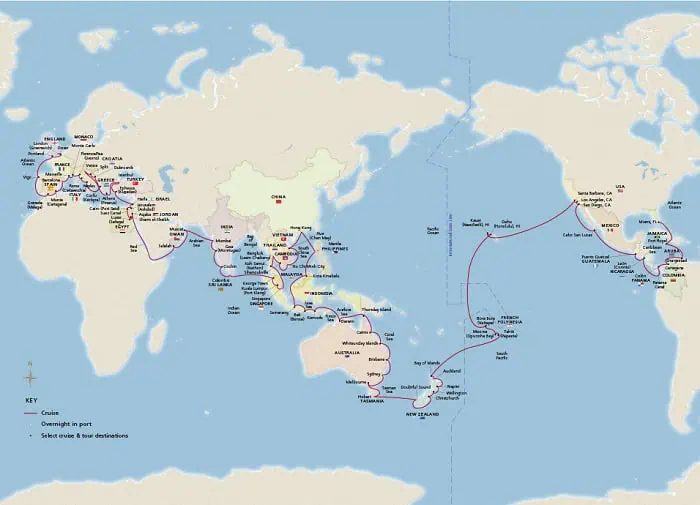
While longer sailings offer the convenience of exploring multiple destinations without the hassle of constant packing and unpacking, they also present significant challenges such as cabin fever, travel fatigue, and limited flexibility. Ultimately, finding the right balance between sea days and port visits and considering individual tolerance for extended time at sea is crucial in determining the ideal length of a cruise.
Our recent 32-day South American cruise showcased the joys and limitations of extended voyages, prompting us to reassess our preferences and travel habits. Alternatives to extended cruises, such as combining land and sea travel or embarking on around-the-world tours or train journeys, offer diverse opportunities for exploration and cultural immersion.
By embracing a mix of travel experiences tailored to our preferences, we can enrich our journeys and create unforgettable memories.






